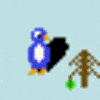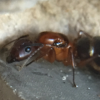Today I found a queen on the sidewalk
1. Location: sidewalk next to fenced in semi forested area
2. Date: 10/18/17 at 3:35 pm
3. Habitat: Sidewalk
4. Length: Will get measurements soon, sorry
5. Features: Dark brown from above view, below is orange as well as legs orange brownish
6. Distinguishing Features: Antennae segments smaller than most of my other queens with a small thickening a the end of the antennae
7. Distinctive other: Very easy to get to crawl on your hand.
8. Nuptial Flight Time: Unknown, still has wings on
9. Nest Desc.: Not seen
10: Sorry for the grainy pictures https://imgur.com/a/G5fYR
Thank you for any replies. ![]()
Please specify whether she is semi or fully claustral, I need to know asap, thanks!

















